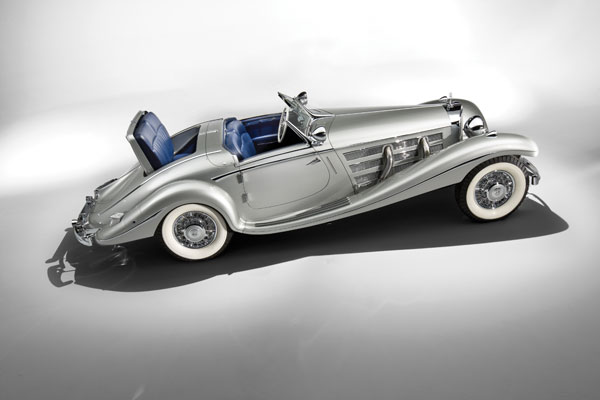SCM Analysis
Detailing
| Years Produced: | 1936–1940 |
| Number Produced: | 419 |
| Original List Price: | $12,000 |
| SCM Valuation: | $3m–$8m |
| Chassis Number Location: | Plate riveted to firewall and stamped into front frame rail. |
| Engine Number Location: | Stamped on left side of block, along with a stamped, riveted plate. |
| Club Info: | Mercedes Benz Club of America |
| Website: | http://www.mbca.org |
| Alternatives: | 1936–1939 Bugatti Type 57SC Atalante coupe, 1937 Delahaye 145, 1937–1938 Talbot-Lago T150C SS Teardrop coupe |
This car, Lot 242, sold for $9,680,000, including buyer’s premium, at RM’s Monterey auction on August 20, 2011.
Pre-war German cars, and Mercedes-Benz in particular, had a reputation for outstanding build quality and attention to detail. Unlike their European counterparts who strove for lightness, Mercedes-Benz cars were overbuilt in the true Teutonic tradition. A massive oval tubed frame was constructed with numerous cross members, and the rear axle was hung with dual coil springs on each side. If one was good, then two was better.
Compare the light alloy rear axle on a Bugatti, or an Alfa, with the heavy, cast-iron one on a Mercedes, and you’ll see what I’m talking about. There was no concern for weight savings, as these cars were built to last. The small doors were hung on massive, chromed hinges, and the car’s fit and finish were exemplary. Technical innovations, such as independent front and rear suspensions, and one-shot chassis lubrication were standard features.
Of all the 540Ks built, the so-called ”High Door, Long Tail, Covered Spare” Special Roadster is considered the rarest and most valuable. They only built about 25 of these cars, and of those, only five or so had the covered spare.
Most luxury manufacturers of that era built cars that were outfitted with custom coachwork. However, Mercedes aficionados prefer the factory Sindelfingen bodies, and our subject Special Roadster doesn’t disappoint.
The chromed radiator is made up of 5,000 individual tubes soldered together and set behind the rear axle. To restore the radiator alone costs about $50,000 today. The sleek, V-shaped radiator, along with the flowing, almost 12-foot-long front fenders, low, chromed windshield and the enclosed spare tire compartment —with just the hint of a fin — make for a very rakish appearance. To my eye, these Special Roadsters, and the ultra-rare Autobahn-Kurier, are the best looking pre-war Mercedes ever built.
An expensive Autobahn cruiser
As beautiful as they are, these cars are very heavy to drive. They certainly don’t have the light — almost delicate — feel of a Bugatti or an Alfa. The inline 8-cylinder engine features a supercharger that is operated by flooring the accelerator pedal. The supercharger ran for short bursts, and it was not the constant type seen on most other cars of the era.
These cars were not especially fast, but they were built for sustained cruising on the Autobahn in complete luxury. In 1937 they cost about $14,000 delivered to the United States — when a similar Cadillac V16 Roadster was a mere fraction of that. As you can imagine, you had to be in a very high income bracket to afford one of these cars during those Great Depression-era days.
And, as this sale shows, you still have to be very wealthy to buy one of these cars.
A blue-chip collectible and competition
Because of their beauty and iconic status, collectors have sought after these cars for decades. Two other German luxury car makers, Horch and Maybach, also offered Special Roadsters, but it’s the Mercedes that collectors seek. The Horch and Maybach cars sell today for about a quarter of what a similar Mercedes is worth.
The car featured here has a wonderful unblemished provenance with no stories. That, coupled with a great restoration and a proven concours history, made for spirited bidding.
I was concerned when I heard it was going to auction with so many other 540Ks on the same weekend. Would that hurt it? While the sale price is the highest ever for a Special Roadster, I do feel it may have brought even more money if there were less competition from other 540Ks in the same auction. I would not have been surprised to have seen a $10m-plus hammer price (the cost of the car before the 10% buyer’s premium is added) if the car had been the only 540K crossing the block.
What the sale of this car did say to me is how important each August on the Monterey Peninsula is for car buyers — and sellers. I don’t think this result could have been achieved at Scottsdale, AZ, or Amelia Island, FL. Monterey Car Week brings the international players out in droves, and it showed in auction results across the board.
Surely, if I have a very special car to sell, Monterey is where I’d bring it. In any case, this car is a guaranteed Blue Chip investment, and I consider it well bought.
(Introductory description courtesy of RM Auctions.)
